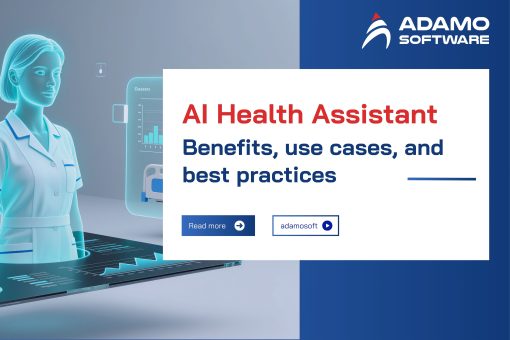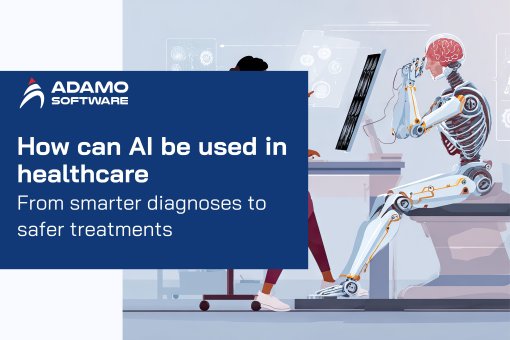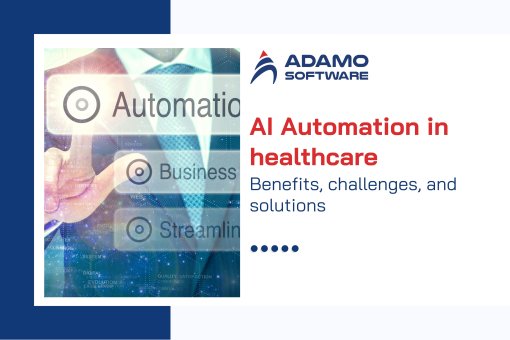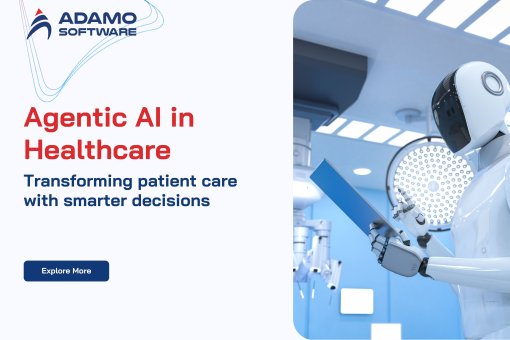Computer Vision in Healthcare: What it is, real hospital use-cases, and limitations
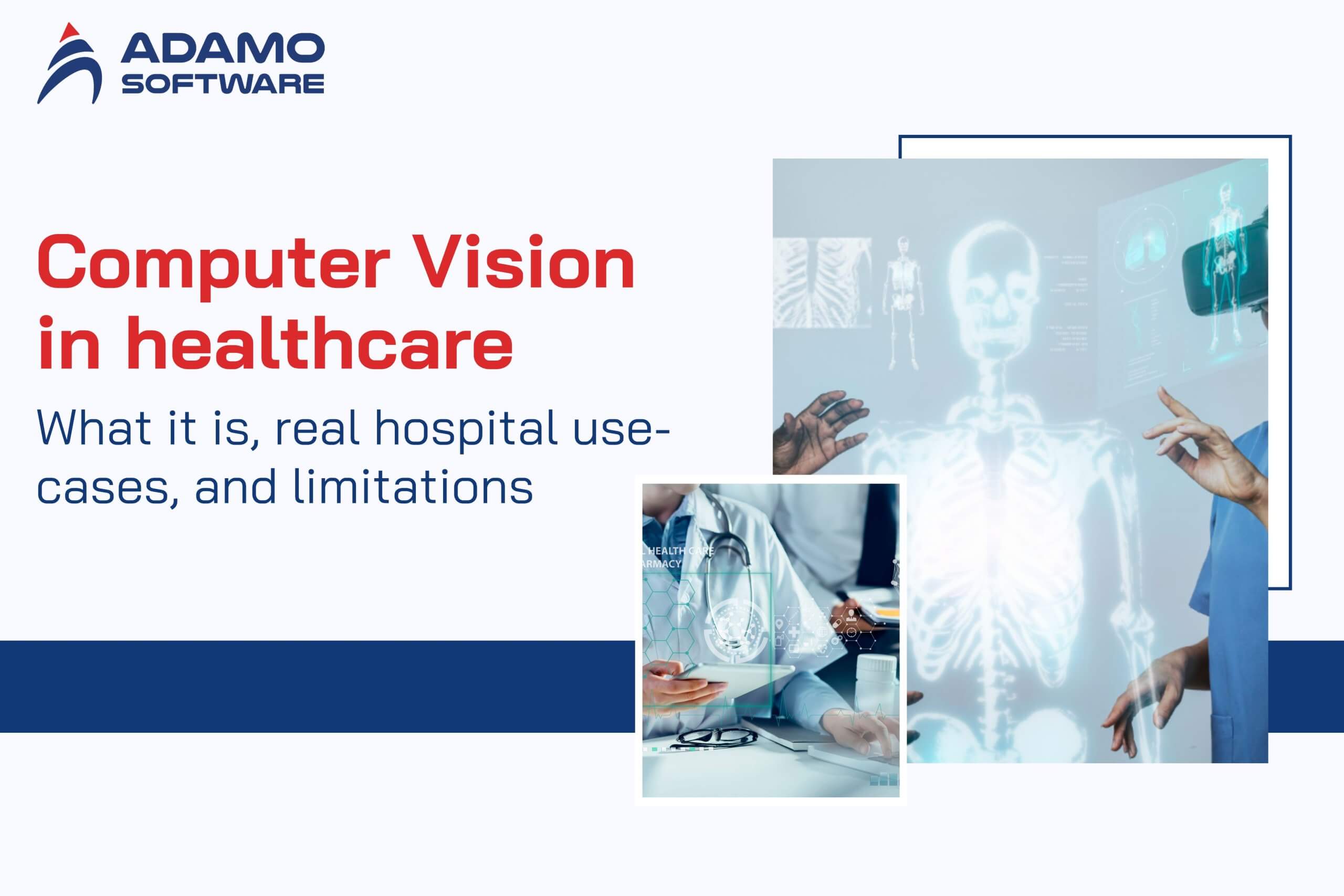
Computer vision in healthcare is extremely beneficial for the healthcare industry. Let’s learn about this technology with Adamo Software!
Currently, healthcare is a leading industry in the adoption of computer vision. Computer vision in healthcare analyzes medical images like X-rays, MRI, CT scans, etc. As a result, doctors can diagnose more quickly and accurately, improving patient treatment outcomes. Besides early disease detection, computer vision contributes to treatment automation and enhanced patient experience. So, what is computer vision in healthcare? Let’s learn about this technology with Adamo Software!
Through this blog post, besides learning the definition of the computer vision in healthcare, you will also know it is used in hospitals and its limitations. All of the information has been thoroughly researched and updated to the latest trends. So, let’s read our blog post and find some useful information.
I. What is Computer Vision in healthcare?
Before getting to know what computer vision in healthcare is, you must understand what computer vision is first. This is a technology that machines use to automatically recognize and describe images accurately and efficiently. It gives computers the ability to extract useful information from image data. It is responsible for recognizing images, detecting objects, segmenting images, and recognizing faces. Besides, it also analyzes motions and processes visual data.
Computer vision for healthcare involves AI analyzing and interpreting medical images. This technology enables the identification, categorization, and tracking of medical images like X-rays, MRIs, CT scans, and dermatological images for diagnosis and treatment. A key feature of computer vision in healthcare is its ability to rapidly process and analyze vast amounts of complex images. Algorithms learn from millions of images to detect subtle pathological signs. This technology analyzes both static images like X-rays and dynamic images from endoscopy or ultrasound.
Besides, computer vision in healthcare can automatically adapt and improve accuracy over time through Deep Learning. AI models improve diagnostic performance and reduce errors through continuous learning from new data. This technology easily integrates with HIS, EMR/EHR, and smart medical devices, enabling data synchronization and optimized treatment.
Thanks to computer vision in healthcare, doctors can make more quick and accurate decisions thanks to shortening the time to read and analyze medical images. This technology also helps to reduce human errors and detect diseases early. Moreover, it also automates multiple testing processes, reducing the burden of testing and operating costs. In addition, computer vision in healthcare also monitors and manages health more effectively, especially in telemedicine models.
You can explore more about How can AI be used in healthcare: From smarter diagnoses to safer treatments here.
Ready to Outsource?
Get top-tier IT talent without the hassle. Contact us now!
II. AI computer vision use cases in hospitals
Computer vision in healthcare speeds up the diagnostic process and improves medical image quality for more precise surgery and expanded remote care. Let’s explore how this technology is used in hospitals with Adamo Software!
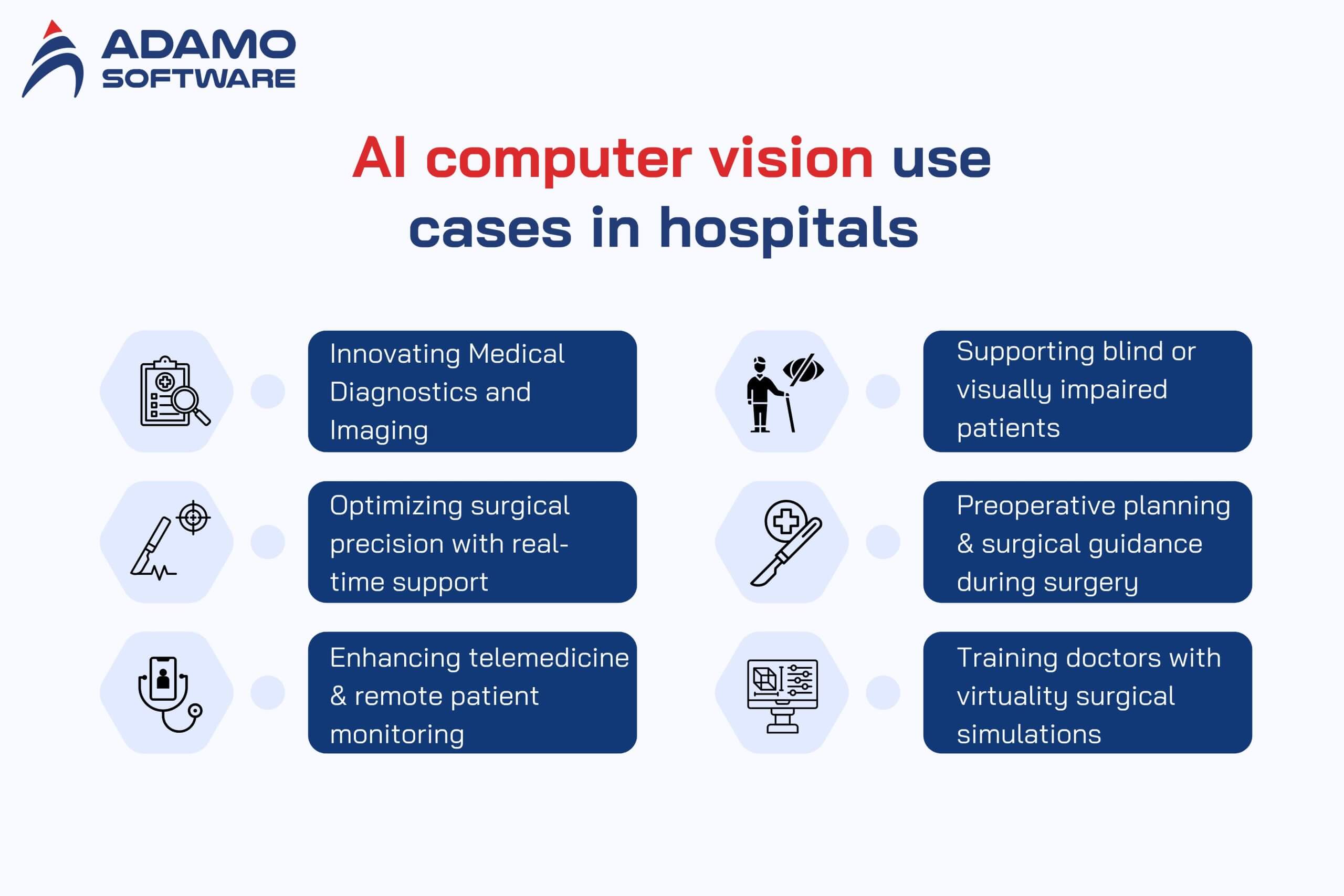
1. Innovating Medical Diagnostics and Imaging
One of the most outstanding applications of the AI computer vision in healthcare is innovating medical diagnostics and imaging. Thanks to this technology, reading and analyzing the X-ray, MRI, CT scan are optimized. It allows computers to simultaneously process various medical images in a short time, automatically detecting abnormalities like tumors, tissue damage, inflammation or fractures. This saves time for doctors and supports finding potential signs of disease.
Besides, this technology also enhances medical image quality. Advanced algorithms automatically improve image sharpness, reduce noise, and adjust contrast, making subtle damage more visible. Some systems even reconstruct 3D images from 2D scans. This enables doctors to gain a more detailed, multidimensional view of internal anatomy. Higher image quality results in more accurate diagnoses and facilitates effective early treatment planning.
The computer vision in healthcare can not only recognize irregularity but it can also categorize pathologies and give initial diagnostic suggestions. For example, in lung cancer diagnosis, AI computer vision can analyze chest CTs to find early, millimeter-scale lung nodules in lung cancer diagnosis, which are hard to see by eyes. Another example is breast cancer diagnosis through mammography. The computer vision technology can automatically analyze risk, thereby proposing BI-RADS classifications for doctors.
2. Optimizing surgical precision with real-time support
Computer vision in healthcare technology plays an important role in improving the accuracy of surgeries. Real-time analysis of smart camera and sensor data helps surgeons precisely identify diseased tissue margins, nerves, blood vessels, and key organs. This technology is especially beneficial in complex surgeries like neurosurgery, cancer, cardiology, and organ transplantation, where even minor details significantly affect outcomes.
In addition to high-quality images, advanced healthcare computer vision automatically warns doctors about dangerous areas or subtle, unusual soft tissue changes. For instance, in neurosurgery, computer vision helps locate functional brain nerves, which is essential for safe brain tumor removal. In cancer surgery, AI aids in marking tumor boundaries with near-infrared imaging, ensuring complete removal and the preservation of healthy tissue.
In cardiovascular surgery, computer vision in healthcare technology provides real-time pulse and blood flow monitoring during procedures like stent placement or heart valve repair. This is especially important in complex liver or lung transplants, where it improves grafting and ensures immediate graft stability.
3. Enhancing telemedicine and remote patient monitoring
Telemedicine is also a field where computer vision in healthcare technology can be adopted. Healthcare systems can use this technology to remotely analyze patient images and videos from mobile devices, surveillance, or wearables for disease detection. For instance, AI cameras can monitor skin changes, detect ulcers, new tumors, or abnormalities like swelling and bleeding.
In addition, computer vision is also strongly applied in inpatient or intensive care patient monitoring systems.
AI analyzes ICU camera images to monitor indicators like breathing rate, posture, unusual movements, and risk of falls. Once it detects dangerous situations, it will immediately send warnings to the medical team. This minimizes response time and saves patients’ lives in many emergency cases.
4. Supporting blind or visually impaired patients
Computer vision in healthcare can assist blind or visually impaired patients in their daily activities. Smart devices will work as vision assistive glasses. They translate the surrounding images into audio guidance to help patients move safely. For example, the system can read road signs, recognize traffic lights, warn of obstacles or support facial recognition of familiar people. This technology leads to a higher quality of life and greater independence for visually impaired individuals and improves their access to education and employment.
5. Preoperative planning and surgical guidance during surgery
Preoperative planning is an essential step to ensure smooth and safe surgery. Before surgery, the surgeon needs a detailed understanding of the injury’s location, related anatomy, and potential risks. Computer vision in healthcare supports this process by recreating 3D anatomical images from CT, MRI or X-ray data. Instead of 2D static images, surgeons can rotate, zoom, or virtually dissect tissue layers to plan the optimal surgical path, clearly identifying areas for avoidance or deep intervention.
In addition to preoperative support, computer vision also closely follows the surgical process to provide real-time guidance. AI constantly analyzes surgical camera and endoscope images, comparing them with pre-planned models to flag deviations or potential risks.
For example, in spine surgery, the computer vision in healthcare technology accurately tracks vertebrae position, aiding precise screw placement without spinal cord damage. Similarly, in liver surgery, this technology supports the clear demarcation of liver segments and the tiny blood vessel system, making tumor removal much safer.
AI computer vision in healthcare can combine with augmented reality (AR) technology to support doctors during surgery. Instead of just 2D screen images, surgeons now view vivid 3D images of internal structures directly on the operating field. Through specialized AR glasses or a display, anatomical models such as blood vessels, nerves, pathological tissues, and tumors are projected onto the patient’s body. Thanks to this, surgeons can accurately visualize the lesion without extensive incisions, improving accuracy, minimizing invasiveness, and optimizing outcomes.
In surgery, the AR system and computer vision in healthcare technology provide continuous real-time image updates, with AI automatically adjusting the AR projection for tissue changes or new lesions. In complex neurosurgery, where brain structures are tiny and fragile, this is especially significant. For instance, in brain tumor surgery, the AR system can guide surgeons to avoid critical functional areas like the language or motor center. Surgeons can quickly adapt their approach due to rapid response and accurate visualization, lowering the risk of neurological complications or permanent patient harm.
6. Training doctors with virtual reality surgical simulations
As modern medical training emphasizes absolute surgical precision and safety, virtual reality (VR) surgical simulation integrated with computer vision in healthcare is an ideal way to train doctors. Rather than solely learning from books or watching live surgeries, residents and young doctors can directly experience realistic surgical simulations. Each simulation is based on real anatomical data from previous cases, with full variations and complex situations that can occur during surgery. This allows learners access to accurate medical knowledge and safe virtual practice of practical skills.
VR surgical simulation allows doctors to experience tactile feedback, pressure, shear force, tissue stiffness or virtual bleeding, making training more vivid and realistic than ever. Computer vision in healthcare technology plays an important role in analyzing trainee actions during simulated surgery, including scalpel use, instrument movement, and precise identification of target tissue. The system records errors and provides immediate feedback for incorrect techniques or safety violations, aiding trainee understanding and skill improvement.
Besides individual training, VR and computer vision also support group training or simulating rare emergency situations. This allows doctors to collaboratively practice responding to unexpected surgical complications, improving quick and effective teamwork.
In general, computer vision in healthcare can be adopted in diagnostic imaging, precise surgical guidance, enhanced remote monitoring capabilities to physician training in realistic simulation environments. These advanced applications improve treatment outcomes, reduce risks, and broaden healthcare access.
III. Limitations of Computer Vision in healthcare
Although computer vision streamlines healthcare, improves workflows, and boosts surgical precision, it presents several key challenges. Let’s learn some limitations of computer vision in healthcare with Adamo Software!
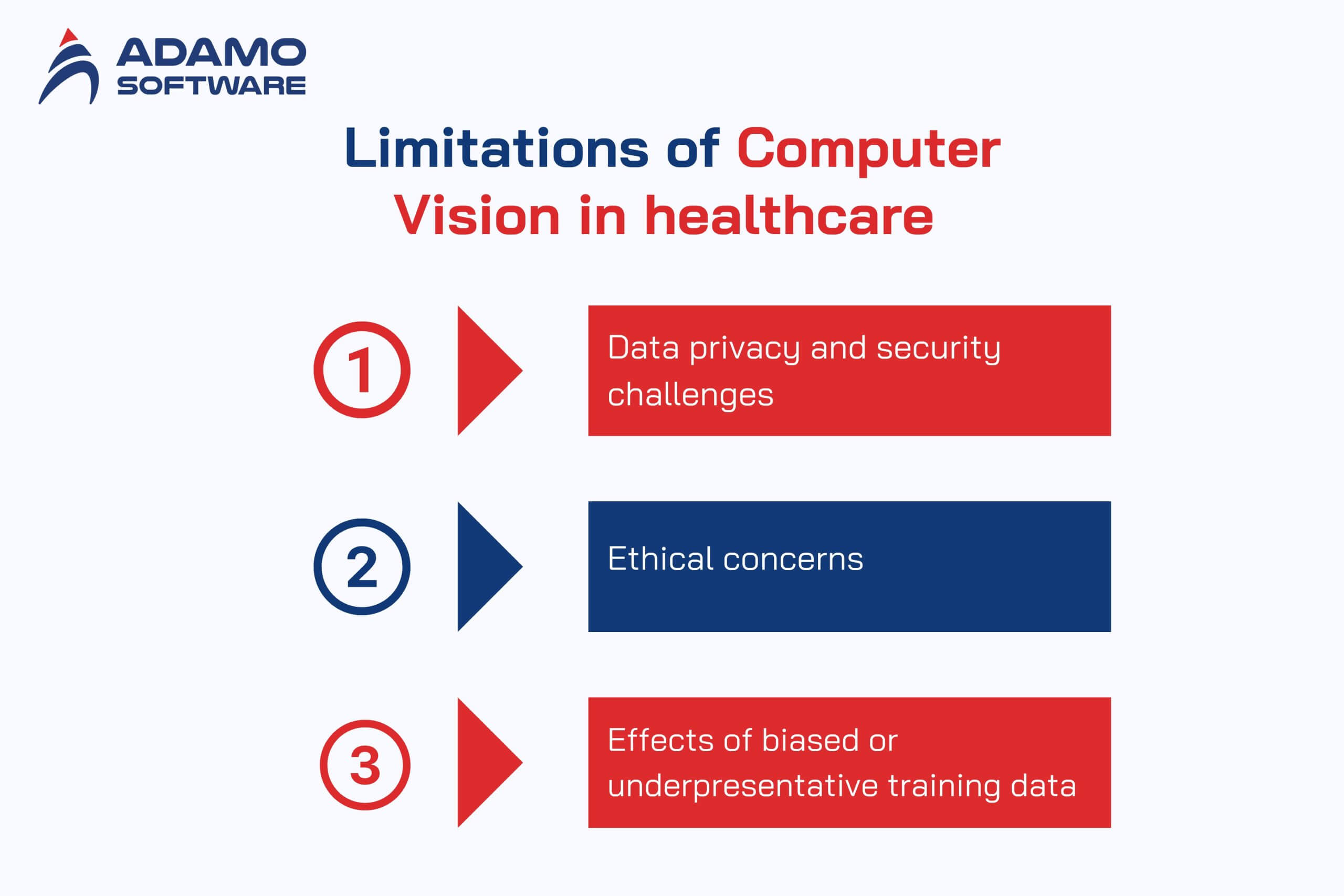
1. Data privacy and security challenges
Data security and privacy are a concern for every industry. And so does healthcare. When implementing computer vision in healthcare, you must concentrate on them. Due to the sensitivity of patient information, the potential for data leakage or unauthorized access requires significant attention. Poor security leads to data theft, fraud, and misuse. Without proper management, patient data could be exploited by organizations or third parties for commercial purposes, including advertising, unauthorized research, or sale to unauthorized parties. These breaches severely impact patient privacy and damage medical facilities’ reputations, eroding public trust in healthcare technology.
Medical computer vision models are often designed to analyze images or videos collected in real time in hospitals or clinics. However, recording might inadvertently capture images of uninvolved individuals like doctors, nurses, relatives, or visitors without their explicit consent. This raises significant privacy concerns, particularly in healthcare where confidentiality and respect are crucial. Without proper controls, image storage and processing could violate legal and ethical rules, causing controversy over AI in healthcare.
To minimize the risks associated with information disclosure and ensure patient privacy, healthcare facilities need to adopt strict data management measures. Data should only be kept as long as needed for diagnosis or treatment, minimizing the risk of prolonged exploitation. AI systems should be designed to retain only truly necessary information and discard redundant data. Besides, strong encryption, clear access rights, data processing monitoring, and compliance with standards like HIPAA/GDPR should ensure patient data confidentiality and transparency throughout its lifecycle.
2. Ethical concerns
The quality and representativeness of training data are crucial when developing computer vision in healthcare. AI systems risk unintentionally learning pre-existing social biases if their input data is biased, such as being skewed towards a particular race, age, gender, or health condition. Consequently, diagnosis or treatment can become discriminatory, resulting in missed or misdiagnosed cases among minorities, older patients, or those with atypical symptoms. This affects system accuracy and also poses significant ethical, equity, and efficiency challenges across healthcare.
To safeguard patient rights and minimize bias, strict ethical principles are necessary for developing computer vision in healthcare. First, transparency must be ensured. Both the medical team and the patient must know about the algorithms, decision criteria, and limitations of the model. Training data must be fully representative of different patient groups to prevent discrimination.
In addition, patient privacy must be absolutely respected through data security and limited collection of personal information. Besides, all computer vision applications in healthcare must support safe diagnosis and treatment without increasing patient risks or harm.
3. Effects of biased or underrepresentative training data
Seriously biased results can occur if medical computer vision in healthcare models are trained on incomplete, inaccurate, or unrepresentative patient data. For example, the system might fail to recognize clinical signs in patients of specific skin color, gender, age, or health conditions if underrepresented in the training data. This can lead to misdiagnosis, missed danger signs, or inappropriate treatment priorities, directly affecting the health and lives of patients. Additionally, biased system outputs can erode medical staff trust, leading to reluctance in using AI tools and delaying digital transformation in healthcare.
A computer vision in healthcare model can only effectively support healthcare by maintaining high accuracy and ensuring its decisions adhere to clinical safety standards. Models must be periodically validated against diverse, up-to-date datasets to guarantee accurate responses in real-world medical contexts. Furthermore, clinical experts must rigorously evaluate the model before official use to confirm the safety and effectiveness of its diagnoses or interventions. Continuous quality control enhances system reliability and helps protect patient rights and health in modern medicine.
IV. How Adamo Software works with Computer Vision in Healthcare
Are you looking for a partner to help you with your computer vision in the healthcare system? As one of Vietnam’s leading technology companies with many years of experience working in the healthcare industry, Adamo Software can be your ideal choice. Adamo Software is a trusted technology partner, providing customized solutions integrating computer vision to improve healthcare efficiency.

With its strength in specialized healthcare software development, Adamo supports hospitals and healthcare organizations in building intelligent medical image analysis systems, from supporting early diagnosis of diseases, such as cancer, cardiovascular, to optimizing surgical procedures with real-time image analysis. In addition, Adamo also designs remote patient monitoring solutions using images, helping to improve outpatient care and detect complications early.
Not only focusing on algorithms, Adamo is committed to developing AI models that strictly comply with data security standards (HIPAA, GDPR), ensuring patient privacy and rights. Besides, Adamo actively applies augmented reality (AR) technology combined with Computer Vision to develop surgical support solutions, medical guidance in the operating room, and surgical simulation platforms for physician training.
With a flexible and customer-centric approach, Adamo Software not only builds customized computer vision in healthcare solutions according to requirements but also accompanies them long-term to ensure that the products are always updated, safe and in line with the digital transformation trend in healthcare. Thanks to that, Adamo becomes the ideal partner for any organization looking for effective, sustainable and standardized medical AI solutions.
Still hesitating whether to choose Adamo Software? Let’s contact us for more detailed information.
FAQs
1. What diseases can computer vision in healthcare help detect in medicine?
Computer vision models can detect and diagnose a wide range of pathologies, including cancer, such as breast, lung, skin, etc. Besides, computer vision in healthcare can also detect cardiovascular disease, neurological disease, and other abnormalities such as bone fractures, chronic obstructive pulmonary disease.
2. How can computer vision in healthcare assist in surgery?
Computer vision in healthcare can analyze images in the operating room and provide real-time information, helping surgeons perform surgeries with greater precision, helping to identify important tissues and avoid unnecessary damage.
3. Can computer vision in healthcare replace doctors in diagnosing diseases?
No, it cannot. However, it can assist them in analyzing images and providing accurate results, thereby helping doctors make better diagnosis and treatment decisions.
4. What is the future of computer vision in healthcare?
The future of computer vision in healthcare is growing rapidly and promises many breakthrough potentials, especially in the context of AI and machine learning technology becoming increasingly powerful. It will continue to evolve to support earlier and more accurate disease detection. In the future, computer vision in healthcare will help automate many processes in medicine, from analyzing X-ray images to monitoring treatment progress. This helps reduce human errors, save doctors time, and deliver more accurate and consistent results.
5. How does a computer vision in healthcare model protect patient privacy?
The model must comply with security standards such as HIPAA or GDPR, encrypt medical image data, and collect only the information necessary to ensure patient privacy.







